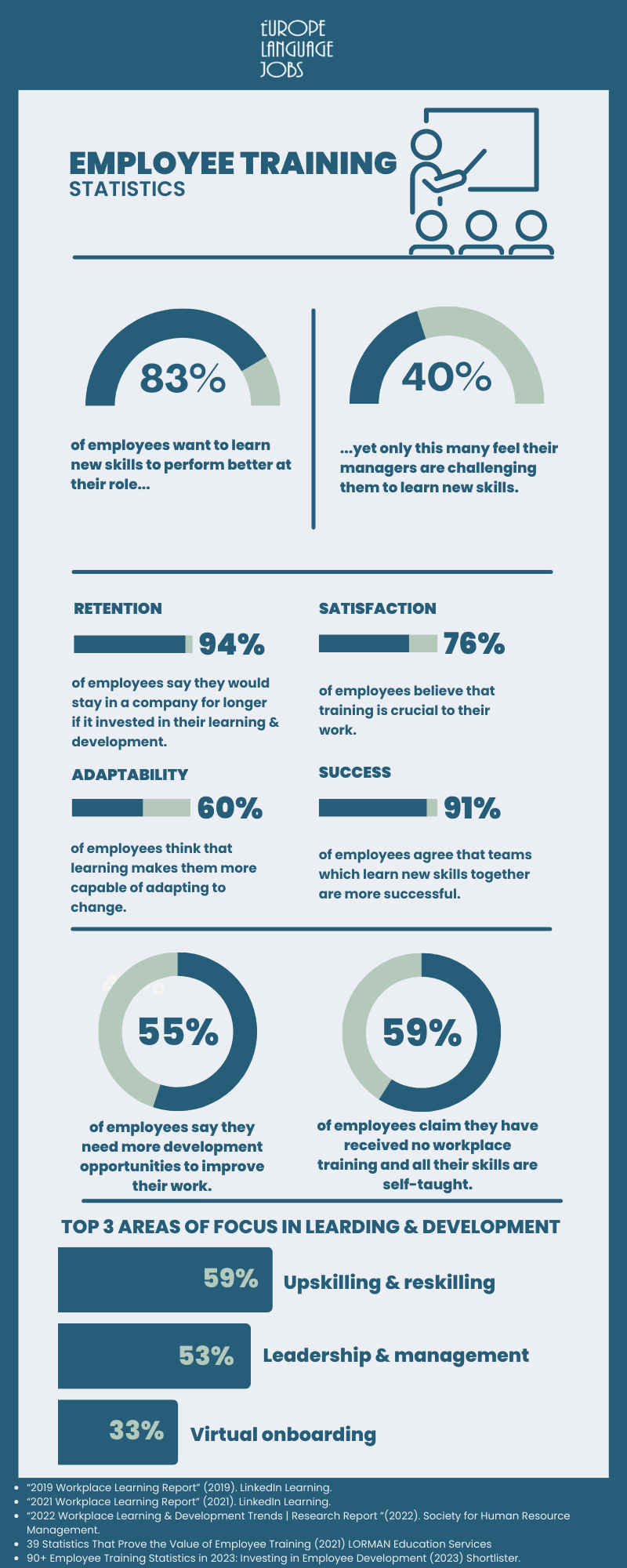Many people use “employee training” as a synonym for “onboarding”. The thing is, employees should not only be trained for the first few days or weeks in their position. They should develop professionally in a continuous manner, throughout the entire course of their career.
The world becomes more dynamic every day, so we all need constant learning to stay on top of the latest updates. There are different methods of effective employee training. Their variety allows each business to select the most convenient ones and implement them into the employee’s schedules.
Before we move on to discuss how to successfully train your employees, let’s explain why that is beneficial for a business.

Benefits of employee training
- Increased employee productivity
- High employee retention
- Improved company reputation
- Tighter community
- Resilience to changes
1. Increased employee productivity
Employees who receive opportunities to improve professionally are more likely to deliver better results. This claim is supported by 90% of HR managers surveyed by Talent MLS.
In order to be productive, employees need to feel motivated. They will naturally want to contribute to a company which openly demonstrates its support by providing them with growth opportunities.
Employment is a two-way street: a business should expect its employees to deliver results, but it must give something in return. These days, a salary is not enough to keep employees coming to work feeling motivated and inspired. They need to feel appreciated and supported by their company to stay on top of their focus.
2. High employee retention
Happy employees are not just more productive. They are also more likely to remain at a company for longer if they are satisfied with the development opportunities it offers.
76% of employees told The Society for Human Resource Management (SHRM) that they would be more likely to stay longer in a company which offers continuous learning opportunities. Similarly, research carried out by LinkedIn revealed that 94% of employees would remain in a business investing in their development for a longer period of time.
The explanation for that is simple. Employees don’t hesitate to quit their jobs when they feel like they have approached a wall and have nowhere else to go. The key to retaining them is to make sure that doesn’t happen. And the simplest way to do this is by ensuring their constant training.
86% of HR managers observe a positive impact of training on the retention of employees - a fact that perfectly supports our claim.
3. Improved company reputation
Employee retention is just one side of the coin. Finding new talent is just as crucial to the growth of a business as keeping the existing employees happy.
More than 80% of HR professionals agree that training does not only help to retain, but also hire talent (SHRM). Yet only 40% of employees feel challenged by their manager to learn a new skill (LinkedIn).
The disparity between those numbers is the perfect opportunity for businesses to improve their reputation. Training - unfortunately - continues to leave a lot to be desired in so many companies. Becoming an employer known for their inspiring growth opportunities is a sure way to keep applications for new positions flowing in.
Gen Zers are a generation on their way to shaking up the job market. Their percentage in the workforce grows every year, which means they will soon become a considerate part of all employees.
Interestingly, 76% of Gen Zers identify learning as the key to a successful career (LinkedIn). Training will; therefore, hold a high spot on their list of expectations while looking for a job.
The number of Gen Z learners accessing professional learning courses provided by LinkedIn has increased 2.5 times just between 2020 and 2021. This shows the speed at which their percentage in the workforce grows every year.
As a generation known to be quite demanding, employers will need to find ways to attract their CVs - and they can start by making their companies known for providing attractive training opportunities.
4. Tighter community
Successful companies recognise the importance of well-functioning teams. After all, those constitute the very base of the company’s structure hierarchy pyramid.
Top-quality management on the highest levels alone cannot make a business function if the employees cannot cooperate effectively. A successful collaboration can be ensured through communication, teamwork, and tangible bonds formed between individuals.
91% of professionals agree that teams which acquire new skills together are more successful (LinkedIn). This is because educating the whole team ensures that it is not just one person mastering a certain skill, but all of the members. It saves time, as it provides equal development among employees.
Naturally, everyone will be more successful in certain areas than in others. Collective learning allows employees to close skill gaps by learning from one another in practice, rather than being forced to upskill individually.
Collective learning also drives employees to be more productive together. Including social features such as shared courses, learning groups, or Q&A sessions in training is proven to drive participants to watch 30 times more hours of content than learners who train individually (LinkedIn).
What’s more, a further 92% of people believe that community learning helps form a sense of belonging. This will improve the relations between employees and create a healthier working environment they will happily return to every day.
5. Resilience to changes
Teaching staff transferable skills is the key to ensuring they remain flexible and adapt easily. Unexpected changes are part of everyday life, especially in today’s dynamic work environment. It is crucial to fool-proof the entire business, including the employees.
60% of employees claim that constant learning makes them more capable to adapt to changes (LinkedIn). The more skills they acquire, the more new situations they can find their way around.
This means that aside from job-specific skills, businesses should train their employees in transferable skills such as management, leadership, work organisation, or effective communication.
Despite the clear benefits of employee training, almost 59% of employees claim they received no workplace training, which led to most of their skills being self-taught (Lorman). A further 55% are not satisfied with the level of training they did receive, saying they need more development opportunities to enhance their performance (Shortlister).
Perhaps the reason why businesses do not provide their employees with sufficient training is that they simply don’t know how to do so efficiently. Below, we will explain the most essential methods of employee training which can be adopted by every type of business.
How to effectively train employees?
- Practise video learning
- Give access to online learning platforms
- Let employees train each other
- Balance industry knowledge and company knowledge
- Deliver relevant training through communication and feedback
- Mix theory and practice

1. Practise video learning
On-site training may be believed to be more reliable, as it somewhat offers a more reliable way to monitor the participants’ engagement. However, this type of learning is no longer always an option in the era of remote work.
You must be inclusive of your remote employees. Offering them video training is much cheaper than covering the costs of their travel to the office to sit through a series of presentations.
That is not to say that in-person learning is a thing of the past. You are free to conduct on-site training, but remember to film every session and make the recordings available to everyone who couldn’t attend.
According to research by Pop Video, people are 95% more likely to remember what they have learnt via video than text. This is why it might be beneficial to turn the company’s policies and goals, which usually come in written form, into videos. This will ensure all employees are on-board and aware of their mission as part of the business.
Since the pandemic, many universities have switched to recorded lectures. They recognise the efficiency of allowing students to access classes at a convenient time and giving them the possibility to rewatch them multiple times.
Video learning can come in the form of entirely pre-recorded sessions, just available online. But it can also be a regular meeting, filmed or streamed live. The latter may be an issue in the case of international businesses with employees spread all over the world and working in different time zones.
In both instances, make sure to invest in a good-quality camera and, even more importantly, a good microphone. You don’t want your effort to go to waste due to faulty equipment.
2. Give access to online learning platforms
Not all training has to be conducted internally. Many businesses do not have the time and resources to fully train their staff via their own courses.
Thankfully, there is a wide variety of online training platforms to choose from. They range from personal development to courses delivering more professional and industry-specific knowledge. Each company is free to do its own research and select the ones that are best adjusted to its needs.
For example, if you are in the nursing industry, online learning platforms offering nurse resources could be of great help to your employees. The platforms offer an opportunity to develop new skills and re-learn essential clinical knowledge to offer better care within their everyday settings, eliminating long lectures and allowing nurses to learn at their own pace using interactive modules.
The value of online course platforms is that the training is usually provided by professionals and experts within a specific field. You do not have to worry about the quality and relevance of the courses, as their standard is usually very high.
This is ensured by the subscription fees required to access said courses. They can vary from reasonable to quite high, so not everyone may be able to afford them individually. Providing full subscriptions or membership discounts for relevant platforms is a great way to show your employees you care and invest in their professional and personal growth.
With 70% of employers preferring this method of employee training, it is by far the most popular one (SHRM).
3. Let employees train each other
The flow of knowledge between employees is usually a natural occurrence in a workplace, but it should still be openly encouraged.
In terms of new workers, shadowing colleagues with more experience in the company is the perfect way of learning the ropes. This does not only apply to those at the start of their career. The same things can be done differently in various workplaces, so it is essential every new recruit passes onboarding training.
But even those who have spent years working for a particular company can still benefit from sharing knowledge. An example of that is cross-training, where employees from different departments learn about each other’s tasks and - most importantly - their impact on the business.
However, even employees within the same department can exchange knowledge. Those with more experience may share their insights with younger colleagues. Additionally, it is natural that everyone is skilled in slightly different areas. You can save on hours of structured training by simply encouraging employees to learn from one another.
This can be done naturally throughout work, but there are also more organised ways. For example, each employee can be asked to suggest their biggest strength and prepare a quick, interactive training session during which they will share their skill with others.
Make sure the areas of expertise don’t repeat so that everyone is given the chance to bring something new to the table. This can be done both in terms of hard and soft skills.
4. Balance between industry knowledge and company knowledge
Providing employees with transferable skills they can use in different areas of their personal and professional lives is important. However, at the same time, one shouldn’t forget it is just as essential to ensure they are familiar with company-specific knowledge.
The easiest way to spread chaos and disorganisation is to leave employees in the dark as to how the machine of their company functions. They need to be aware of how their roles impact others and understand the bigger picture.
Some too many employers provide their staff with an access code to an online learning platform of their choice and consider their role in employee training done. However, outside training, no matter how good, will not deliver the company-specific knowledge that is just as crucial.
Transparency regarding the company’s policies, methods, and values is especially essential in the age of remote work. Employees who have never set foot in the office and never personally met most of their colleagues will need extra guidance regarding their role in the company’s community, as well as the business’s inner workings.
In an era of window-dressing and gaslighting, setting clear objectives is more important than ever. Employees on all levels in the hierarchy must understand the why before the how in order to successfully carry out the roles and have a positive impact on business development.
A study by LinkedIn identified the following areas as the top 3 areas of focus for learning and development in 2021:
-
Upskilling and reskilling (59%)
-
Leadership and management (53%)
-
Virtual onboarding (33%)
This demonstrates that regular training in terms of the company’s goals and values remains overlooked. It is most likely addressed in the area of virtual onboarding, but once it’s completed, the focus switches to honing hard and soft skills.
As the professional world and the market constantly change and evolve, so do the details regarding the businesses’ methods and goals. It is important to follow up on them every now and then, and make sure employees adjust their activity accordingly.
5. Deliver relevant training through communication and feedback
76% of employees believe training is crucial to their work. However, this only refers to relevant training.
Teaching transferable skills does not mean teaching random skills. Similarly, cross-training should be kept sensible. While employees need to be flexible and able to perform more than just the basic tasks required of their position, they also mustn’t be the jacks of all trades, and masters of none.
73% of people want to learn more about a topic they are personally interested in. But 83%, 10 percentage points more, want to learn skills to perform better in their current role.
This means that professionals aren’t interested in just cultivating their hobbies at the company’s expense. They genuinely want to grow as valuable members of the workforce, and expect their training to be relevant to their career path.
How to ensure this?
The answer is rather straightforward. It is as simple as effective communication.
Ask your employees what areas they want to develop in. Listen when they tell you what skills are most important to them, and analyse whether they overlap with skills you wish them to have as an employer.
Communication is a two-way street. Before crafting an employee training plan, ask the target audience about the expected outcomes on their side. Once you have collected and implemented the answers, make sure each session is started by outlining the aims of this particular training and the learning outcomes the participants will obtain.
In the end, ask for feedback. Were the suggestions implied successfully? Did the training meet the previously expressed expectations? Is there room for improvement?
Of course, it is impossible to satisfy every little request. The answers should be analysed and approached collectively to identify areas which are most popular among the responders. But do take into consideration every voice before finding a common denominator for them all.
After all, providing training that will keep the employees happy, works in favour of the entire business. Professionals who feel heard and adequately educated will be more productive, motivated, and loyal to the company that provided them with effective growth opportunities.
6. Mix theory and practice
In order to be effective, theory and practice need to go hand in hand. They also need to be evenly distributed, so that neither aspect outweighs the other.
34% of major organisations agree with this statement, using a mixed-learning approach in their internal training processes (Training Magazine). When it comes to the employees’ opinion, 62% of them prefer hybrid learning opportunities (SHRM).
This means that a very theoretical approach delivered by an online course should be followed by tasks which will allow employees to implement the newly gained knowledge in practice. This can be done for example by a mentorship programme, where a mentor can oversee whether the mentee can actually transform theory into practice.
Learning purely for the sake of learning is not sustainable. If a learner cannot apply the newly obtained skills to their actual work, it can mean two things. The training they are receiving may be irrelevant and ill-suited for their role. However, it might just be a question of using mixed-learning approaches to combine guidance both in theory and practice.
The steps to ensuring effective employee training are not as daunting as they may seem in theory. They all come down to effective communication, a well-designed training process, and not doing things just for the sake of doing them.
The benefits of training your employees clearly demonstrate that it is something to take into consideration and implement into the employees’ life cycle at the company. It will be an investment, but it will pay off in terms of increased productivity, lower employee turnover, and improved company reputation.
Sources:
-
“2019 Workplace Learning Report” (2019). LinkedIn Learning.
-
“2021 Workplace Learning Report” (2021). LinkedIn Learning.
-
“2022 Workplace Learning & Development Trends | Research Report” (2022). Society for Human Resource Management.
-
39 Statistics That Prove the Value of Employee Training (2021) LORMAN Education Services. Available at: https://www.lorman.com/blog/post/39-statistics-that-prove-the-value-of-employee-training (Accessed: April 4, 2023).
-
90+ Employee Training Statistics in 2023: Investing in Employee Development (2023) Shortlister. Available at: https://www.myshortlister.com/insights/employee-training-statistics (Accessed: April 4, 2023).
-
Freifeld, L. (2019) 2019 Training Industry Report, Training Mag. Available at: https://trainingmag.com/2019-training-industry-report/ (Accessed: April 4, 2023).
-
Survey: The State of Learning & Development (2022) TalentLMS. (Accessed: April 4, 2023).
-
Young, M. (2016) Looking at the Facts - Why Video Content Has the Highest Retention Rate, Pop Video. Available at: https://www.popvideo.com/blog/looking-at-the-facts-why-video-content-has-the-highest-retention-rate (Accessed: April 4, 2023).















Venisia Nedeva11mo ago
Really helpful information.
Really helpful information.